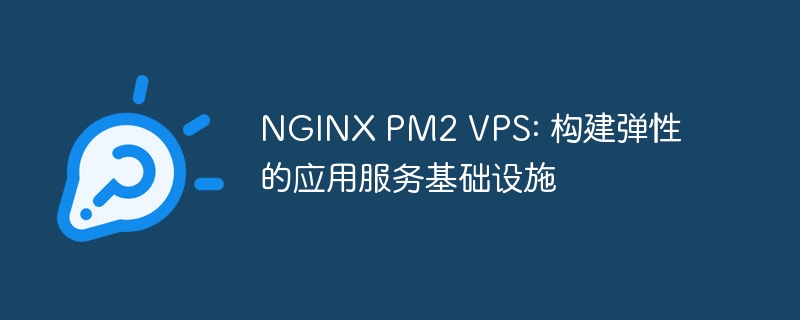Home >Operation and Maintenance >Nginx >NGINX PM2 VPS: Building a resilient application service infrastructure
NGINX PM2 VPS: Building a resilient application service infrastructure
- 王林Original
- 2023-09-27 15:49:11915browse

NGINX PM2 VPS: Building a flexible application service infrastructure requires specific code examples
With the development of the Internet and the increase in application requirements, building flexible application services Infrastructure emerged as an important technical challenge. NGINX, PM2 and VPS (Virtual Private Server), as three important technical components, can help us achieve high-availability and high-performance application deployment and management. This article describes how to use these three components to build a resilient application service infrastructure and provides code examples for reference.
1. NGINX introduction and application examples
NGINX is an open source, high-performance, lightweight web server and reverse proxy server with excellent performance and stability. It supports a variety of application scenarios and can be used for static file serving, load balancing, reverse proxy, HTTP caching, etc.
The following is a basic NGINX configuration example for forwarding requests to the backend application server:
http {
upstream backend {
server backend1.example.com;
server backend2.example.com;
}
server {
listen 80;
location / {
proxy_pass http://backend;
}
}
}This configuration forwards requests to the backend application server through a reverse proxy, achieving Load balancing and high availability.
2. PM2 introduction and application examples
PM2 is a process management tool that can help us manage and monitor applications. It supports Node.js-based applications and various scripting languages, and can automatically restart applications, log management and performance monitoring.
The following is a simple PM2 configuration example for starting and managing a Node.js application:
pm2 start app.js --name=myapp --watch pm2 log myapp
This configuration will start a Node.js application named myapp and execute the Automatically restart the application when changed. You can view application logs through the pm2 log command.
3. VPS introduction and application examples
VPS is a virtualization technology that provides more flexible and scalable server resources by dividing a physical server into multiple virtual servers. VPS provides an independent operating system environment, independent file system and independent network configuration, which can meet the needs of different applications.
The following is a simple VPS configuration example for creating a VPS server based on a Linux system:
sudo apt-get update sudo apt-get install nginx sudo apt-get install nodejs sudo apt-get install pm2
This configuration example demonstrates how to install NGINX, Node.js and PM2. Through these commands, you can deploy a Node.js application on the VPS and use NGINX as a reverse proxy server.
To sum up, by combining NGINX, PM2 and VPS, we can build a flexible application service infrastructure. NGINX provides high-performance and reliable reverse proxy functions, PM2 provides application process management and monitoring capabilities, and VPS provides a flexible and scalable server environment. By properly configuring and using these components, we can achieve highly available and high-performance application deployment and management.
The above is a brief introduction and examples of NGINX, PM2 and VPS in this article. I hope it will be helpful to readers. In specific practical applications, more detailed configuration and adjustment are required according to actual needs.
The above is the detailed content of NGINX PM2 VPS: Building a resilient application service infrastructure. For more information, please follow other related articles on the PHP Chinese website!

